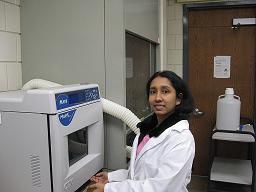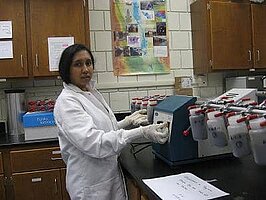Chemical Fingerprinting of Sediments and Water of the Souris River and Turtle River for Identification of Diffuse Pollution Sources

Dimuthu Wijeyaratne is a Graduate Student (PhD) in ECS (Environmental Conservation Science Program) in the North Dakota State University. She completed her B.S. in Zoology at the University of Kelaniya, Sri Lanka. Currently her research focuses on chemical fingerprinting of wetland sediments
Dimuthu.Wijeyaratne@ndsu.edu
Phone: 701-231-7087
Fellow: Dimuthu Wijeyaratne
Advisor: Dr. Marinus Otte, Professor, Department of Biological Sciences, North Dakota State University
Matching Support: North Dakota State University, ND Department of Health
Degree Progress: PhD in Environmental Conservation Science Program expected in May 2011.
Chemical Fingerprinting of Sediments and Water of the Souris River and Turtle River for Identification of Diffuse Pollution Sources
Description of the project :
The project so far focused on the Souris River, which originates in Saskatchewan, then passes through North Dakota to return to Canada in Manitoba. There is international concern regarding phosphate in the water and the cross-border consequences of pollution transport. The river drains a large watershed which supports a wide range of land uses. In this project the potential for tracing sediments acting as phosphate sources to the Souris River has been assessed using the ‘chemical fingerprinting’ technique. The data obtained from the Souris River will be applied to about a study on sediment loading and transport in the Turtle River in North Dakota. The Turtle River is known to have high sediment concentrations of Cd, Se and As, and is an ‘impaired’ river of concern to the North Dakota Department of Health.
Scope and objectives of the research project:
The proposed research is a continuation from the ongoing work supported by WRRI in 2008 and 2009. The objectives are:
- To obtain chemical fingerprints of sediments of the Turtle River.
- To assess the concentration of Cd, Se, As and other contaminants in sediments and water at selected sites of the Turtle River to identify potential sources of pollution.
- To assess the spatial variation in element concentrations in sediments and water and relate them to the land use patterns.
- To assess the biogeochemical behavior of elements in sediments and water of the selected areas of the Turtle River and Kelly Slough.
- To assess the relationship between sediment source areas and sink areas along the rivers using river simulation models in the laboratory.
- To assess the contribution of pollutants from source areas at different mixing ratios of sediments in the source areas.
- To geographically model the variation of concentrations of elements along the Souris River and Turtle River.
- To geographically model potential sediment and pollutant sources along the Souris River and Turtle River.
Progress:
In August 2008 and 2009 sediment samples from the top layer of the riverbed were collected from tributaries along the Souris River. Chemical fingerprints were developed for each site using the element concentrations. Based on the results a simple equation was developed to find the contribution of the tributary to the sediments assuming a linear mixing between tributary and upstream sediments. The assumptions concerning sediment mixing and effects on element concentrations, and the explanations for depletion/enrichment will be further investigated with controlled laboratory experiments. It is also proposed to determine the chemical fingerprints of sediments of the Turtle River in greater detail than done so far for the Souris River in order to assess the spatial variation along the river.
Research Outcomes:
Wijeyaratne D., Jacob D and Otte M April 2008. Chemical Fingerprinting of Sediments of the Souris River to assess the transport of phosphorous and other pollutants 5th Annual Northern Plains Biological Symposium, 2008. Fargo, ND. [Poster]
Wijeyaratne D., Lin, W., Otte, M., Jacob, D., The potential of element concentrations in sediments of the Souris River, North Dakota for multi-element fingerprinting and sediment tracking. (In preparation).
Wijeyaratne D., Otte, M.,Jacob, D., Oduor, P., Determining the Level of Pollution in Upper Souris River: A Case Study. (in preparation)
Wijeyaratne D., Jacob D and Otte M April 2010. Chemical fingerprinting and determination of tributary contribution of trace elements in the upper Souris River, ND 7th Annual Northern Plains Biological Symposium, 2010. Fargo, ND. [Poster]
Significance:
Sediments are an important source of information regarding the occurrence and magnitude of environmental contamination. Sediments can act both as sinks and sources of pollutants to the overlying water column and biota. Chemical fingerprinting identifies the distribution of chemical elements within a matrix and thus defines its unique signature in comparison to similar matrices. It provides a sediment profile, which can then be used for direct sediment source tracing. This involves determining the concentrations of many elements simultaneously by Inductively Coupled Plasma spectrophotometry (ICP). Sediment fingerprinting is a method to identify nonpoint source pollutants in a watershed through the use of natural tracer technology with a combination of field data collection, laboratory analyses of sediments, and statistical modeling techniques.


Marinus Otte
Biological Sciences
Office: Stevens 121
Telephone: 701-231-8708
Email: marinus.otte@ndsu.edu


